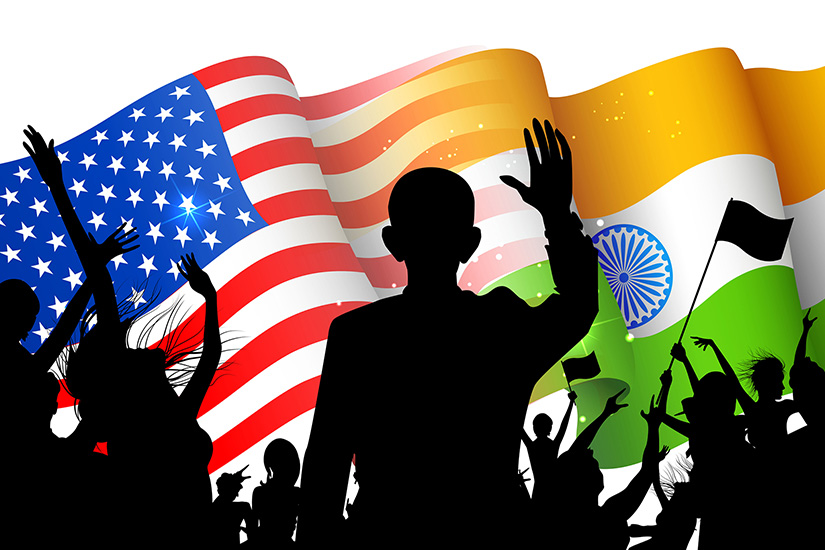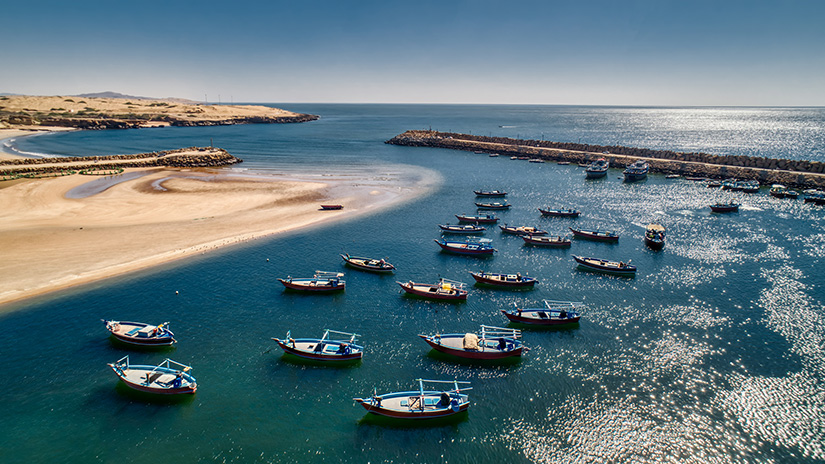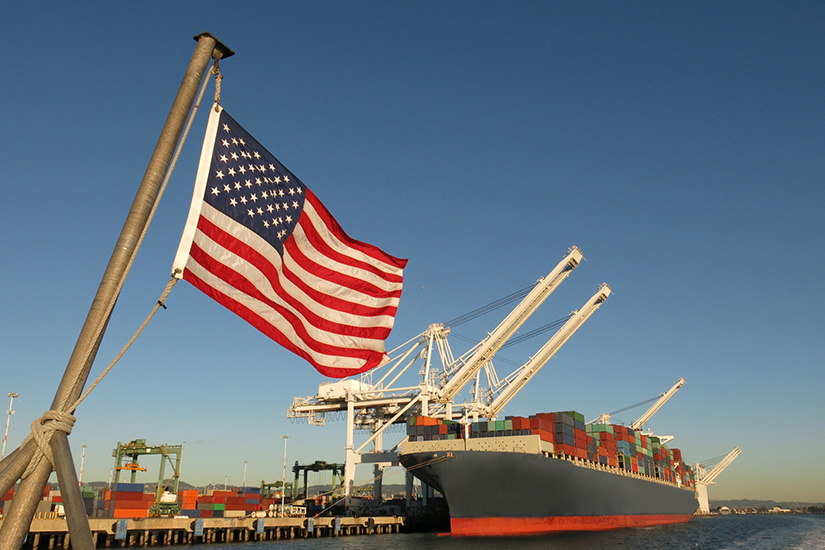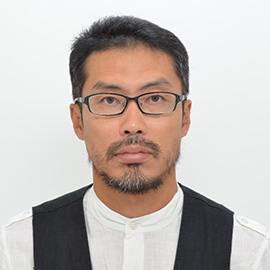U.S. President Donald Trump has returned to the White House.[1] Since the presidential election last fall, India has stood in contrast to the majority of countries who have been nervously awaiting the arrival of Trump 2.0. On November 6th 2024, Indian Prime Minister Narendra Modi seemed to have been waiting for Trump’s declaration of victory when he posted a number of photos on his X page, showing the two together during affectionate moments in his first term. The photos were accompanied with congratulations for Trump’s “historic election victory”, calling him “my friend.”[2] Not only that, he directly phoned him on the same day. The elated Trump praised both India and Modi as “magnificent”, and extolled them as a “true friend.”[3]

Modi’s motives to welcome Trump’s return
There are a number of motives behind Modi’s welcoming attitude. Structurally, while India is a member of the QUAD, it is not in a formal alliance with the United States. Therefore, unlike Japan, Korea, or Europe, it is not in a position to fear demands that it take on a greater share of any alliance burden, nor that it could be abandoned if it refused.
Another crucial factor is the fact that policies valuing India as an indispensable strategic partner for the United States have come to enjoy bipartisan support. This structure of the Indo-American relationship underpinned the faith of India’s External Affairs Minister S. Jaishankar when he said prior to the election that “we have actually seen steady progress in our relationship with the U.S. over the last five presidencies. Including an earlier Trump presidency. So, when we look at the American election, you know we are very confident that whatever the verdict, our relationship with the United States will only grow.”[4]
Additionally, the two leaders have an exceptionally good personal relationship. When Modi visited the U.S. during Trump’s first term in September 2019, the president rushed to join a “Howdy Modi” gathering that had mobilized 50,000 Indian Americans. In February of the following year, when Trump visited India, Modi reciprocated by filling a new cricket stadium to its capacity of 100,000 people to hold a “Namaste Trump” gathering. The two politicians have extraordinarily similar personal traits, from their emphasis on top-down summit diplomacy, to their tendency toward performative gestures to their nations, and further to the fact that they make no secret of their nationalism and ideological focus on prioritizing their own countries. From Modi’s perspective, Trump is someone he can comfortably get along with.
Finally, it must be pointed out how serious friction in the bilateral relationship became under Biden. The former president’s administration openly expressed concerns and criticisms about the Modi government’s authoritarianism, the retreat of religious and press freedoms in India, and human rights abuses. For instance, at a press conference held for the April 2022 U.S.-India Foreign and Defense Ministers’ dialogue (2+2), U.S. Secretary of State Antony Blinken issued a warning that “we are monitoring some recent concerning developments in India including a rise in human rights abuses by some government, police and prison officials.”[5] In March 2024, when a revision to India’s citizenship law passed that was discriminatory towards Muslims, the U.S. expressed concerns and stated that “respect for religious freedom and equal treatment under the law for all communities are fundamental democratic principles.”[6] Additionally, when Indian authorities arrested the chief minister of Delhi, a powerful opposition leader, shortly before the general election, the State Department issued a statement, encouraging “fair, transparent, timely legal processes.” Needless to say, this infuriated the Modi government, who strongly rejected the U.S.’s intervention.[7]
In the latter half of 2023, suspicions were raised that the Research and Analysis Wing (RAW), India’s foreign intelligence agency, was plotting the murder of Sikh leaders critical of the Modi administration in America, after being accused of having done the same in Canada. The U.S. Department of Justice charged not only the Indian national who directly participated, but also a former official at RAW who was alleged to have given the orders.[8] It was also reported that central figures in the Modi government, such as National Security Advisor Ajit Doval, were suspected of involvement in the series of plots.[9] On the eve of Trump’s inauguration, the Indian Ministry of Home Affairs released a report which acknowledged the involvement of a former RAW official, identified as an “individual”, straining to bring the matter to a close.[10]
Furthermore, in November 2024, The U.S. DOJ and Securities and Exchange Commission indicted Gautam Adani, the head of an emerging Indian conglomerate, for bribery and other crimes.[11] Adani is extremely close to Modi, and heads a number of projects inside and outside of India. Putting him on trial could put his cozy relationship with the Modi administration under harsh scrutiny. Immediately, major projects in countries such as Kenya, Sri Lanka, and Bangladesh began to be cancelled or reviewed.[12]
Trump 2.0 has “freed” India from these frictions with the United States. It is well known that Trump is indifferent to human rights and democratic values to begin with. Indeed, when appointing the new director of the Federal Bureau of Investigation (FBI), he selected a close associate who is a major critic of the DOJ and FBI, the Indian-American Hindu Kash Patel.[13] Following his inauguration, Trump issued an executive order pausing the enforcement of the Foreign Corrupt Practices Act (FCPA).[14] This has heightened the possibility that the cases of the former RAW official and Adani will remain unresolved. For the Modi government, this is truly an act of salvation.
Worries about uncertainty
Naturally, there are still concerns about Trump 2.0 and its “America First” priorities. Firstly, like many other countries, it is certain that India will be struck with tariffs. While America’s average tariff on India is 2.2%, it is reported that India imposes 12% on the U.S., and, while small compared to theamount of deficit withChina, Japan, and others, America has a trade deficit with India. Undoubtedly, there will be demands to reduce import taxes and increase imports of American manufactured goods and energy.[15] Despite this, the dominant perspective is optimistic, believing that as long as America recognizes China as its primary threat, it will continue to trend toward integrating India into supply chains, through means such the Initiative on Critical and Emerging Technology (iCET) and the construction of semiconductor manufacturing facilities in India.[16]
Secondly, there are concerns about the Trump administration’s restrictions on immigration. During his first term, the H1-B visa category for skilled professionals became stricter, and dissatisfaction spread among Indians, who make up 70% of the recipients of H1-B visas. Following the most recent election, white supremacists who supported Trump also advanced an anti-Indian hate campaign on social media.[17] However, the businessman Elon Musk, who supported Trump early on with large campaign donations, has defended the importance of H1-B visas due to the necessity of acquiring competent personnel, making it ultimately unclear what the president will decide on.[18]
What is clear is that he will take a strict stance on “illegal” immigration. Unauthorized immigrants from India in America are believed to number as many as 725,000, making them the next largest group after those from Mexico and El Salvador,[19] and the Trump 2.0 administration has strongly demanded India take measures against illegal immigration in a foreign ministerial meeting and in a phone conversation between the two leaders following the inauguration.[20] In a highly publicized move just before a face-to-face summit that will be discussed later, 104 Indian illegal immigrants were forcibly deported to India on an American C-17 transport aircraft with their hands and feet bound.[21]
Geopolitically, considering India’s important partnerships with Russia and Iran, there are concerns that Trump 2.0 will take stricter measures against the latter, though his negative attitude toward providing aid to Ukraine and desire for a swift resolution to the war suggests he will be lenient on the former. Indeed, Trump quickly signed a national security presidential memorandum, declaring that maximum pressure would be put on Iran. Worries have therefore emerged that, unlike during his first term, Trump will not approve sanctions waivers for India for its continuing development on the Chabahar Port.[22]
Thus, while the Modi administration is generally positive about Trump 2.0, it nevertheless also is worried about the uncertainty of how his administration will treat them, and what kind of deals he will try to make.

Modi 3.0 and Trump 2.0 – The First Summit
It was in this context that Trump welcomed Modi to the White House on February 13th. The fact that this came so quickly after the visits of the Israeli and Japanese Prime Ministers, Benjamin Netanyahu and Shigeru Ishiba, could be considered evidence of how strongly Trump 2.0 is prioritizing Modi 3.0. Trump welcomed Modi with a warm hug and firm handshake, telling him “we missed you a lot.”
Looking at the joint statement [23] and press conference [24] from the summit, it can be inferred that there have been changes in emphasis and amendments in several areas of the U.S.-India relationship following the Biden administration. The first of these is the trend toward placing more emphasis on defense cooperation. Defense is positioned as the first item in the joint statement. Trump, in addition to the cooperation on defense equipment already agreed under the Biden administration, indicated that he would even approve the provision of F-35 jets to India, which had previously been denied amid fears that its stealth technology could be leaked to Russia.[25] The second is the strength of interest in trade issues. Trump has in the past criticized India, for example calling it a “tariff king”, but an agreement was made to put together a bilateral trade agreement that will address points of concern by the fall of 2025. To do this, India appears to have agreed to calls to buy American petroleum and LNG, which Trump had sought in order to reduce the trade deficit. Third, there has been a decline of interest in climate change, green energy, and other issues prioritized by the Biden administration. These issues were not mentioned whatsoever in the joint statement. Fourth is the incorporation of stronger measures against illegal immigration. Modi, while maintaining that the majority of illegal immigration is due to human trafficking, nevertheless declared his intention to take back any Indian nationals who had illegally entered the U.S. Indeed, the day following the summit and the day after that, India accepted the forced repatriation of its citizens on American military aircraft.[26] Fifth, although the Quad grouping of Japan, the U.S., Australia, and India, was mentioned, and it was formally confirmed that Trump would be invited to the Quad Leaders’ Summit to be held in Delhi in 2025, there was no mention of the Indo-Pacific Economic Framework (IPEF) launched by the Biden administration. Economic coordination in the Indo-Pacific could thus be expected to decline.
On the other hand, it was clearly indicated that collaborations within the Middle East framework, which had started under Biden, would be continued and strengthened. It was confirmed that the I2U2, made up of the U.S., India, Israel, and the United Arab Emirates, as well as the India–Middle East–Europe Economic Corridor (IMEC) would continue to be advanced. It was further made clear that there was to be no change in cooperation on supply chain resilience. While the joint declaration does not use the conventional term “iCET”, it includes the establishment of a “U.S.-India TRUST (‘Transforming the Relationship Utilizing Strategic Technology’) initiative”, to achieve a similar purpose. It is described as promoting cooperation on critical and emerging technologies in domains such as defense, artificial intelligence, semiconductors, and space. This is a relief for India.
At the press conference, Modi took Trump’s “MAGA” (Make America Great Again) slogan to describe his own goal of making India a developed nation as “MIGA” (Make India Great Again), stating that MAGA and MIGA together would become a “MEGA” partnership, stressing his affinity for America under Trump.[27] Of course, this utterly delighted the U.S. President.
The largest focal point going forward will be the outcome of a deal between Trump 2.0, who wants to play the reciprocal tariff card to address the trade deficit, and Modi 3.0, who will take up that challenge. It is possible that factors such as H1-B visas and Chabahar Port will play a role in that deal. The personal relationship between the two leaders is undoubtedly an asset for India, but it may not be possible to avoid reducing tariffs on the US or liberalizing bilateral trade.[28]However, the future is not clear for Modi’s ruling party, lost a large number of seats in the 2024 general election, as it will not be easy to overcome opposition from the strong protectionist instinct in the country.

(2025/03/14)
Notes
- 1 Please refer to my article from four years ago [Japanese only]; Toru Ito, “Toranpu kara Baiden he – Indo・Modi Seiken no Kitai to Kenen” (From Trump to Biden – Expectations and concerns for the Modi Administration in India), International Information Network Analysis, January 6, 2021.
- 2 PM Modi’s X post, November 6, 2024.
- 3 “Modi Congratulates Trump For ‘Spectacular Victory’; Trump Calls Modi, India ‘Magnificent’,” The Wire, November 7, 2024.
- 4 Comments from the day of the presidential election: Suhasini Haidar, “Trump or Harris, India-U.S. ties, Quad will ‘only grow’, says Jaishankar,” The Hindu, November 6, 2024.
- 5 Kanishka Singh, “U.S. monitoring rise in rights abuses in India, Blinken says,” Reuters, April 12, 2022.
- 6 “US ‘concerned’ about CAA implementation in India, says ‘closely monitoring’,” Hindustan Times, March 15, 2024.
- 7 Lucas Lilieholm, Sania Farooqui and Aishwarya S. Iyer and Rhea Mogul, “India summons US State Department official over call for fair legal treatment of arrested opposition leader,” CNN, March 28, 2024.
- 8 “U.S. charges former India spy linked to murder plot in New York,” Washington Post, October 17, 2024.
- 9 Greg Miller, Gerry Shih, and Ellen Nakashima, “An assassination plot on American soil reveals a darker side of Modi’s India,” Washington Post, April 29, 2024.
- 10 Ministry of Home Affairs, “High Powered Enquiry Committee submits its report to the Government,” January 15, 2025.
- 11 Momoe Ban and Takanori Okabe, “Beitoukyoku, Indo Zaibatsu Adani shi wo Kiso Kakkyou IPO ni Hiyamizu mo” (U.S. Authorities launch indictment against Indian conglomerate head Mr. Adani, pours cold water on thriving IPO), Nihon Keizai Shimbun, November 21, 2024.
- 12 Sonu Vivek, “Adani Group deals at risk: How countries have reacted after bribery charges,” India Today, November 26, 2024.
- 13 “Who Is Indian-American Kash Patel, Donald Trump's Pick To Head FBI,” NDTV, December 1, 2024.
- 14 “Foreign Corruption Law That Trump Has Paused Was Invoked in Adani Bribery Indictment,” The Wire, February 12, 2025.
- 15 Andrea Shalal, “India's high tariffs are a barrier to imports, White House's Hassett says,” Reuters, February 11, 2025.
- 16 “India could face trade skirmishes under Trump 2.0 offset by China+1 strategy,” The Hindu BusinessLine, November 6, 2024.
- 17 “'Rise of Anti-Indian Hate Posts on X by Trump Supporters is Organised, Systemic Hatred': Report,” The Wire, January 10, 2025.
- 18 “Masuku shi to MAGA Ha Tairitsu Guroobaru・Bijinesu・Koramunisuto Rana・Foruuhaa” (Musk Faces off Against MAGA Faction, Global Business Columnist Rana Foroohar), Nihon Keizai Shimbun, January 10, 2025.
- 19 Jeffrey S. Passel and Jens Manuel Krogstad, “What we know about unauthorized immigrants living in the U.S.,” Pew Research Center, July 22, 2024.
- 20 In his first post-inauguration phone call with Modi, Trump brought up the issue of illegal immigration, and said he believed India would do “what is right” with regard to it; “Trump Says He Discussed 'Illegal Immigrants' With Modi in Post-Inauguration Call,” The Wire, January 28, 2025.
- 21 The Indian opposition parties strengthened their criticisms of the government over this, claiming that it was a violation of human rights and an insult to the country; “'Humans, Not Prisoners': Opposition Slams Govt for Justifying US Shackling of Indian Deportees,” The Wire, February 6, 2025.
- 22 Keshav Padmanabhan, “Concern for India as Trump orders State Dept to ‘modify or rescind’ Chabahar sanction waivers,” The Print, February 5, 2025.
- 23 The Whitehouse, “United States- India Joint Statement,” February 13, 2025.
- 24 The Whitehouse, “President Trump Hosts a Press Conference with Prime Minister Narendra Modi,” February 13, 2025.
- 25 Nandita Bose and Mike Stone, “Trump says US to increase military sales to India, eventually provide F-35 jets,” Reuters, February 14, 2025.
- 26 Kusum Arora, “Second Military Flight With 119 Indian Deportees Arrives from US,” The Wire, February 15, 2025.
- 27 Ministry of External Affairs, “English translation of Press Statement by Prime Minister Shri Narendra Modi during the India - USA Joint Press Conference,” February 13, 2025.
- 28 Immediately prior to Modi’s visit to the U.S., India announced a new proposed budget that would lower tariffs on high-end motorbikes and cars, as well as smartphone components; Satoshi Iwaki, Yukihiro Sakaguchi, “Modi shi, Tairitsu Kaihi wo Yuusen Bei In Shunou Kaidan, Boueki Kuroji Sakugen he Kyougi Sekiyu・Buki no Yunyuu Zou Yakusoku” (Modi prioritisies avoiding conflict at Indo-American Summit, promises to negotiate on reducing trade surplus and import more oil and weapons), Nihon Keizai Shimbun, February 15, 2025.

